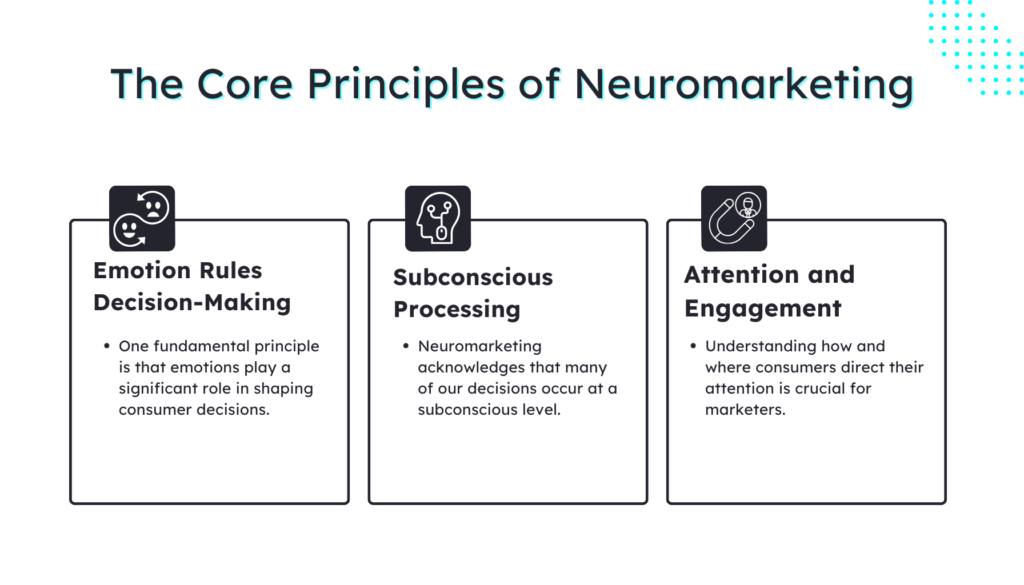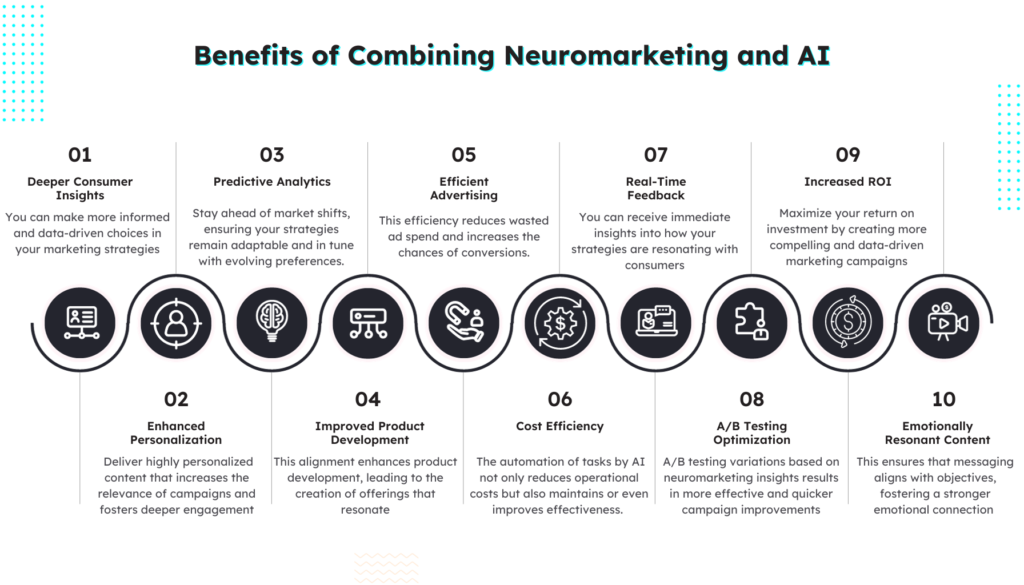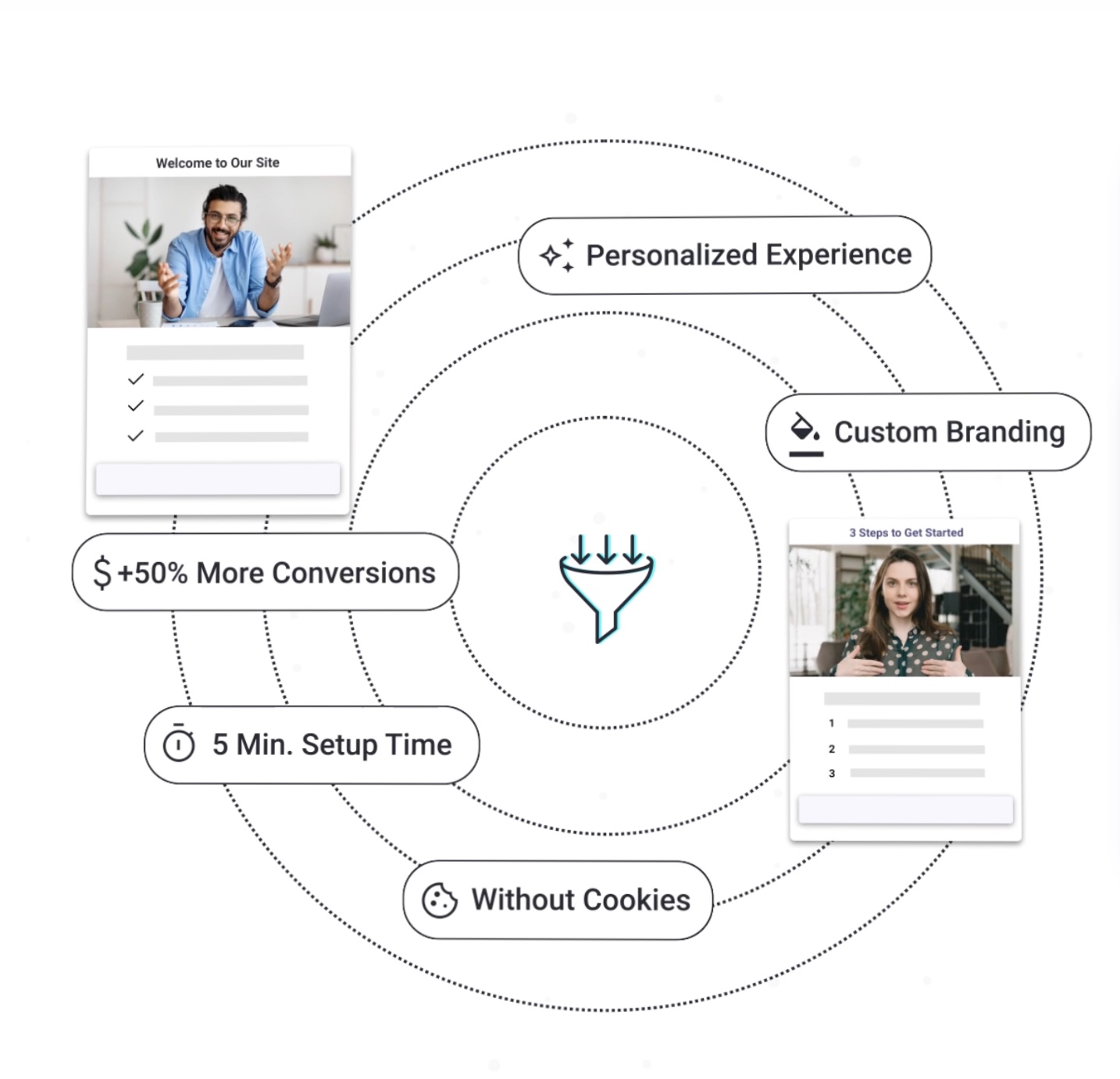The NeuroAI Connection: How Neuromarketing and AI Complement Each Other


In a world where consumers are bombarded with an overwhelming array of choices and information, neuromarketing offers a powerful lens into the human mind. It delves into the subconscious, exploring the intricacies of emotions, preferences, and decision-making processes. Meanwhile, artificial intelligence, with its computational prowess, thrives on data analysis, pattern recognition, and predictive modeling. When these two worlds collide, a synergistic relationship emerges that’s transforming the marketing landscape as we know it.
This blog post explores the fascinating intersection of neuromarketing and AI, revealing how these complementary forces are reshaping the way businesses connect with their audiences. We’ll delve into the core principles of each, discuss the potential benefits of their integration, navigate the ethical considerations, and showcase real-world applications that are changing the game for marketers. It’s clear that the NeuroAI connection is a powerful tool for businesses seeking to unlock the full potential of their marketing strategies in an increasingly data-driven world. Let’s dive in!
The Core Principles of Neuromarketing
Neuromarketing is a multidisciplinary field that combines elements of neuroscience, psychology, and marketing to gain deeper insights into consumer behavior and preferences. At its core, neuromarketing seeks to understand how the human brain responds to various marketing stimuli. It involves the application of neuroscientific techniques and principles to unravel the mysteries of consumer decision-making.
- Emotion Rules Decision-Making: One fundamental principle is that emotions play a significant role in shaping consumer decisions. Neuromarketing focuses on identifying the emotional triggers that drive purchasing choices, recognizing that people often make decisions based on how a product or advertisement makes them feel.
- The Power of Subconscious Processing: Neuromarketing acknowledges that many of our decisions occur at a subconscious level. Often, consumers may not be fully aware of why they prefer one product over another. Neuromarketing seeks to tap into this subconscious decision-making process to uncover hidden motivations and preferences.
- Attention and Engagement: Understanding how and where consumers direct their attention is crucial for marketers. Neuromarketing uses techniques like eye-tracking and EEG (electroencephalogram) measurements to determine which elements of an advertisement or product draw the most attention and engagement.

How the Brain Reacts to Marketing Stimuli
The brain’s response to marketing stimuli is a fascinating aspect of neuromarketing. It involves the use of various neuroimaging technologies such as functional magnetic resonance imaging (fMRI) and electroencephalography (EEG) to observe and measure brain activity while individuals interact with marketing materials.
For instance, when a person encounters a compelling advertisement, specific areas of the brain associated with reward and pleasure, such as the nucleus accumbens, may become active. This activity is a clear indication of the emotional impact the marketing content has on the viewer.
Neuromarketing research has shown that the brain often reacts more positively to narratives and storytelling, as they create a deeper emotional connection. Additionally, sensory elements, such as vibrant colors, appealing visuals, and relatable characters, can trigger heightened brain activity and capture the audience’s attention.
To illustrate the practical application of neuromarketing, let’s take a look at a couple of case studies:
- Coca-Cola’s Neuromarketing Success: Coca-Cola employed neuromarketing techniques to assess the impact of different label designs on consumer preferences. By monitoring brain activity, they discovered that labels featuring the classic red color and the iconic ribbon evoked a stronger emotional response, ultimately influencing purchase decisions. This led to a significant increase in sales for Coca-Cola.
- Super Bowl Commercials: Several Super Bowl commercials have used neuromarketing to create engaging and memorable advertisements. By measuring brain responses and emotional engagement, marketers can refine their ads to resonate more effectively with their target audience.
Understanding neuromarketing and how the brain responds to marketing stimuli is a critical foundation for leveraging the power of AI in enhancing marketing strategies. The insights gained from these principles provide a valuable backdrop for the integration of AI to refine marketing campaigns and foster deeper connections with consumers.
The Intersection of Neuromarketing and AI
The fusion of neuromarketing and artificial intelligence represents an exciting frontier in the marketing landscape. These two disciplines, seemingly distinct, offer unique insights into consumer behavior and the power to harness data-driven decision-making. When brought together, they create a synergy that can revolutionize how businesses engage with their target audiences.
As we briefly mentioned before, neuromarketing techniques include the use of functional magnetic resonance imaging (fMRI) to observe brain activity, eye-tracking to trace visual attention, and galvanic skin response (GSR) to measure emotional arousal. The resulting data provides invaluable insights into how consumers react to various marketing stimuli, from advertisements to product packaging. It’s like peering into the brain’s command center, allowing you to understand what resonates with your audience on a deep emotional level.
On the other side of the equation, AI steps in as the powerhouse of data analysis, predictive modeling, and automation. Its aptitude for processing vast datasets, identifying patterns, and automating tasks is a game-changer in the marketing realm. Machine learning algorithms, natural language processing (NLP), and predictive analytics are just a few of the tools in AI’s arsenal that marketers can leverage.
AI has the capacity to scrutinize mountains of consumer data, drawing meaningful conclusions that might otherwise remain concealed. It excels in identifying subtle patterns in consumer behavior and translating them into actionable insights. This analysis can encompass historical data, real-time user interactions, and even predictive analytics to forecast future trends.
The magic happens when neuromarketing and AI join forces. AI, with its data-processing capabilities, transforms the wealth of data gathered from neuromarketing studies into actionable insights. It unravels the patterns in brain activity and emotional responses, allowing you to refine your strategies with remarkable precision.
For example, by analyzing neuromarketing data, AI can predict which elements of an advertisement evoke strong emotional responses in the audience. It can then recommend adjustments to messaging, design, or even product features to align more effectively with consumer preferences. As a result, marketing campaigns become not just tailored but finely calibrated to target the emotional triggers of the audience.
AI’s real-time feedback capabilities ensure that marketing strategies remain adaptive and responsive. Campaigns can be adjusted on the fly, leading to quicker optimizations and improved engagement.

Benefits of Combining Neuromarketing and AI
The synergy between neuromarketing and artificial intelligence (AI) offers a wealth of advantages if you’re looking to elevate your marketing strategies and connect with your target audience on a profound level. Here’s an in-depth exploration of these benefits:
- Deeper Consumer Insights: Merging neuromarketing and AI techniques provides marketers with a profound understanding of consumer behavior, emotions, and preferences. By tapping into the emotional and subconscious aspects of decision-making, you can make more informed and data-driven choices in your marketing strategies.
- Enhanced Personalization: AI’s ability to analyze neuromarketing data empowers you to deliver highly personalized marketing content. This level of personalization not only increases the relevance of campaigns but also fosters deeper customer engagement, as customers feel like their unique needs and desires are acknowledged.
- Predictive Analytics: The fusion of neuromarketing and AI enables the prediction of future trends and consumer responses. You can stay ahead of market shifts, ensuring your strategies remain adaptable and in tune with evolving consumer preferences.
- Improved Product Development: By using neuromarketing data analyzed by AI, you can refine product designs and features. This alignment with consumers’ emotional triggers and desires enhances product development, leading to the creation of offerings that resonate with the target audience.
- Efficient Advertising: AI-driven algorithms optimize ad placement, ensuring that marketing materials reach the right audience at the most opportune times. This efficiency reduces wasted ad spend and increases the chances of conversions.
- Cost Efficiency: The automation of routine marketing tasks by AI not only reduces operational costs but also maintains or even improves campaign effectiveness. This is particularly beneficial if you’re seeking to maximize your marketing budget.
- Real-Time Feedback: Incorporating AI into marketing efforts provides real-time feedback on campaign performance. You can receive immediate insights into how your strategies are resonating with consumers, enabling them to make rapid adjustments as needed.
- A/B Testing Optimization: AI’s capacity to suggest A/B testing variations based on neuromarketing insights results in more effective and quicker campaign improvements. This reduces the time and resources spent on trial and error.
- Increased ROI: The synergy between neuromarketing and AI allows you to maximize your return on investment by creating more compelling and data-driven marketing campaigns. This leads to increased customer engagement and conversion rates.
- Emotionally Resonant Content: AI can recommend content adjustments that are more likely to evoke desired emotional responses in consumers. This ensures that the messaging aligns with brand objectives, fostering a stronger emotional connection between the brand and its audience.
- Improved Customer Retention: Personalized and emotionally resonant marketing campaigns foster stronger connections with customers, leading to increased customer loyalty and higher retention rates. Customers are more likely to remain loyal to brands that understand and cater to their preferences and emotions.
- Competitive Advantage: If you successfully integrate neuromarketing and AI, you can gain a competitive edge by crafting more persuasive and customer-centric marketing strategies. They stand out in the marketplace by delivering campaigns that resonate with consumers on a deep emotional level.
- Targeted Advertising: AI’s ability to segment audiences based on neuro responses allows you to create laser-focused, highly targeted marketing campaigns. This precision increases the relevance of marketing materials and the chances of conversion.
- Ethical and Transparent Marketing: AI can help maintain ethical marketing practices by providing insights into consumer trust and sentiment. It ensures that marketing efforts remain transparent and responsible, fostering a positive brand image.
- Data-Driven Decision-Making: The combination of neuromarketing and AI encourages data-driven decision-making. It reduces guesswork and uncertainty, increasing the effectiveness of marketing strategies and leading to more informed and strategic choices.
- Optimized Customer Journey: AI can map the customer journey based on neuro responses, allowing for the design of an optimized and emotionally engaging path from awareness to conversion. Customers are guided through a seamless and emotionally resonant experience.
- Innovative Content Creation: AI tools can assist in generating innovative and creative marketing content that aligns with the emotional preferences of the target audience. This results in content that stands out and captures the audience’s attention.
Elevating Neuromarketing with Pathmonk Accelerate: A Revolution in Lead Generation
Pathmonk Accelerate is a cutting-edge AI-powered conversion optimization tool that leverages the principles of machine learning to predict the next most likely steps of website users. It meticulously analyzes a vast array of data, from user behavior to engagement patterns, to understand the emotional and subconscious cues that influence decision-making.
More Sales From Your Website With AI
Personalized interactions based on your users' behaviour to get +50% more conversions.

By predicting what a visitor is most likely to do next, Accelerate can tailor the content and offers a website user is seeing, resonating with their emotional triggers and preferences, to increase chances of conversion.
Pathmonk Accelerate aids in designing an optimized customer journey, ensuring your users have a seamless, enjoyable, and emotionally resonant experience on your website.
By implementing Pathmonk Accelerate, users will experience a boost of +50% conversions on average, cutting their acquisition rate in half and automatically lifting their ROI.
Conclusion
The convergence of neuromarketing and artificial intelligence is transforming the marketing landscape, offering an extraordinary fusion of emotional insight and data-driven precision. The partnership between these two disciplines is much more than a passing trend; it is a strategic leap that is revolutionizing how you can connect with your audiences.
Neuromarketing, with its core focus on emotional and subconscious triggers, unveils the depths of consumer behavior and desires. AI, on the other hand, excels in data analysis, predictive modeling, and automation. Together, they create a synergy that empowers us to deliver more personalized, efficient, and emotionally resonant campaigns. This fusion resonates with the principles of neuromarketing, which aim to connect with consumers on an emotional and subconscious level.
Through the power of AI, neuromarketing insights are translated into actionable strategies that elicit the right emotional responses from the audience. The predictive capabilities of AI ensure that campaigns remain adaptive, enabling marketers to stay ahead of market shifts and consumer trends.





